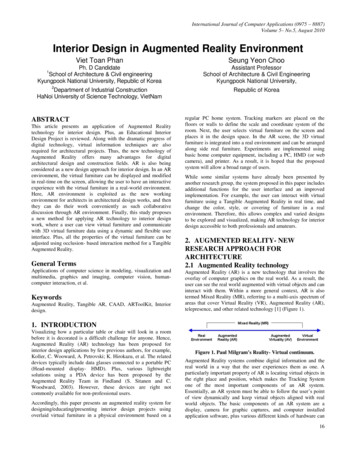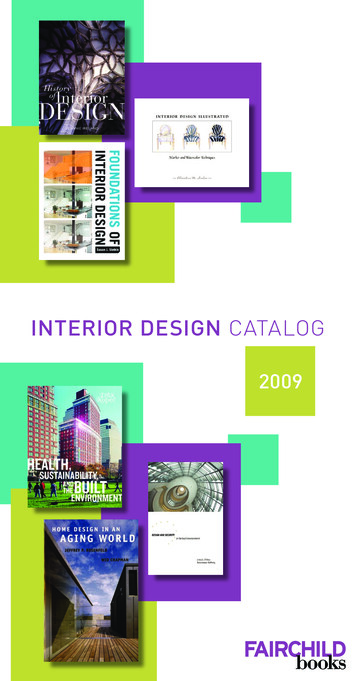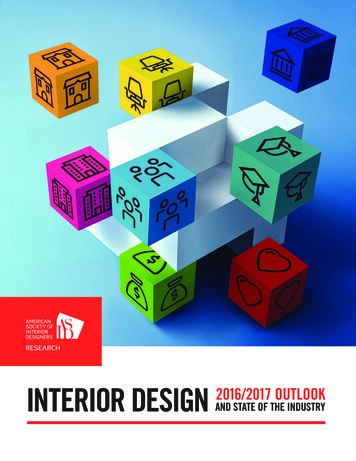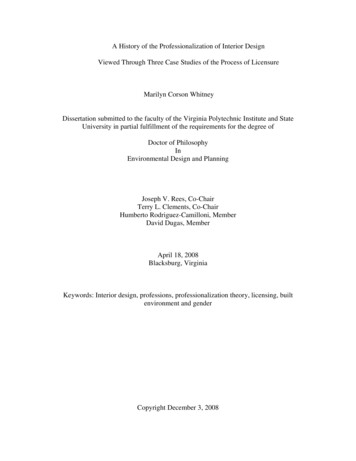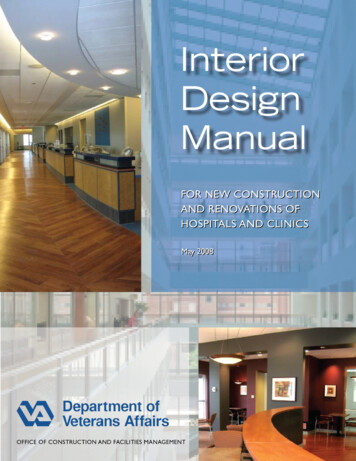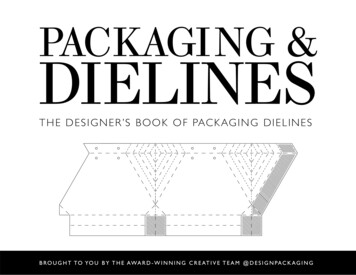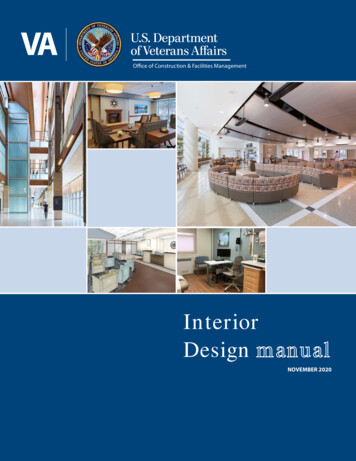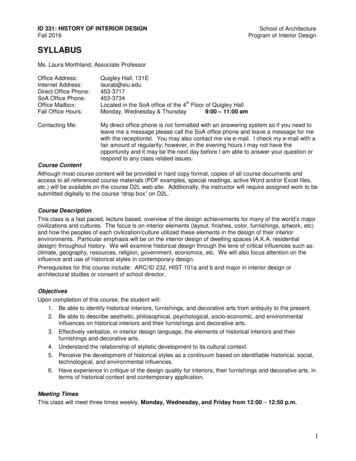
Transcription
ID 331: HISTORY OF INTERIOR DESIGNFall 2016School of ArchitectureProgram of Interior DesignSYLLABUSMs. Laura Morthland, Associate ProfessorOffice Address:Internet Address:Direct Office Phone:SoA Office Phone:Office Mailbox:Fall Office Hours:Quigley Hall, 131Elaurab@siu.edu453-3717453-3734thLocated in the SoA office of the 4 Floor of Quigley HallMonday, Wednesday & Thursday9:00 – 11:00 amContacting Me:My direct office phone is not formatted with an answering system so if you need toleave me a message please call the SoA office phone and leave a message for mewith the receptionist. You may also contact me via e-mail. I check my e-mail with afair amount of regularity; however, in the evening hours I may not have theopportunity and it may be the next day before I am able to answer your question orrespond to any class related issues.Course ContentAlthough most course content will be provided in hard copy format, copies of all course documents andaccess to all referenced course materials (PDF examples, special readings, active Word and/or Excel files,etc.) will be available on the course D2L web site. Additionally, the instructor will require assigned work to besubmitted digitally to the course “drop box” on D2L.Course DescriptionThis class is a fast paced, lecture based, overview of the design achievements for many of the world’s majorcivilizations and cultures. The focus is on interior elements (layout, finishes, color, furnishings, artwork, etc)and how the peoples of each civilization/culture utilized these elements in the design of their interiorenvironments. Particular emphasis will be on the interior design of dwelling spaces (A.K.A. residentialdesign) throughout history. We will examine historical design through the lens of critical influences such as:climate, geography, resources, religion, government, economics, etc. We will also focus attention on theinfluence and use of historical styles in contemporary design.Prerequisites for this course include: ARC/ID 232, HIST 101a and b and major in interior design orarchitectural studies or consent of school director.ObjectivesUpon completion of this course, the student will:1. Be able to identify historical interiors, furnishings, and decorative arts from antiquity to the present.2. Be able to describe aesthetic, philosophical, psychological, socio-economic, and environmentalinfluences on historical interiors and their furnishings and decorative arts.3. Effectively verbalize, in interior design language, the elements of historical interiors and theirfurnishings and decorative arts.4. Understand the relationship of stylistic development to its cultural context.5. Perceive the development of historical styles as a continuum based on identifiable historical, social,technological, and environmental influences.6. Have experience in critique of the design quality for interiors, their furnishings and decorative arts, interms of historical context and contemporary application.Meeting TimesThis class will meet three times weekly, Monday, Wednesday, and Friday from 12:00 – 12:50 p.m.1
GENERAL STRUCTUREFor this course you will be required to do a fair amount of prep reading prior to lecture as well as note takingon both verbal and visual information during the class. The basic requirements for all students enrolled in ID331 will be open book study tests, mid-term exam, a final exam, and a semester long research project whichwill result in a written article.Additionally, most class periods will conclude with a “Fast Forward” piece that the instructor has compiled inorder to connect historic and contemporary design aspects. You are being asked to select five (5) of thesepieces throughout the term and respond to them in short essay form. These short essay responses will askfor your assessment of a selected contemporary interior design (or related design element such as furniture,textiles, etc) based on that day’s historical content. These response essays are due to the D2L drop box bythe beginning of the next class period. You may opt to replace one (1) low grade essay with a sixth essayduring the term.Each essay is worth a maximum of 10 points (See GRADING & EVALUATION section for additional details).Textbook RequiredAmbercrombie, S. & Whiton, S. (2007). Interior Design & Decoration, Sixth Edition. Upper SaddleRiver, NJ: Pearson Education, Inc.Course Outline RequiredMorthland, L.M. (2016) – Cost 22; Available at The Printing Plant 608 S. Illinois Avenue,Carbondale, IL 62901 Ph: (618) 529-3115Suggested TextWoods, G. (2002). Research Papers for Dummies. Indianapolis, IN: Wiley Publishing, Inc.Instructor Reference Texts (In addition to the main text)Blakemore, R. (2006). History of Interior Design & Furniture: From Ancient Egypt to NineteenthCentury Europe, Second Edition. Hoboken, NJ: Wiley Publishing, Inc.Bourdier, J.P., & Minh-ha, T.T. (2011). Vernacular Architecture of West Africa: A World in Dwelling.New York. Routledge.Boyce, C. (1985). Dictionary of Furniture. New York: Henry Holt & CompanyCrochet, T. (1999). Designer’s Guide to Furniture Styles. Upper Saddle River, NJ: Prentice-Hall, Inc.Daniels, I. (2010). The Japanese House: Material culture in the modern home. New York: Berg.Ireland, J. (2009). History of Interior Design. New York: Fairchild Books, Inc.Jani, V. (2011). Diversity in Design: Perspectives from the non-western world. New York: FairchildBooks Inc.King, R. (2008). Art: Over 2,500 Works from Cave to Contemporary. New York. DK Publishing.Pile, J. (2005). A History of Interior Design, Second Edition. Hoboken, NJ: Wiley Publishing, Inc.Pina, L. (2003). Furniture in History: 3000 B.C. to 2000 A.D. New Jersey. Pearson Education, Inc.Slotkis, S. (2006). Foundations of Interior Design. New York: Fairchild Books, Inc.Winchip, S. (2010). Visual Culture in the Built Environment: A Global Perspective. New York.Fairchild Books, Inc.NOTE: Our SoA librarian, Sarah Prindle, is a lifeline for research assistance and development. Her officehours are Mondays 2:00-5:00pm at the Morris Library Information Desk, and Fridays 10:00am-1:00pm in heroffice (Morris Library 260C). You can contact her anytime with questions or for an appointment atsprindle@lib.siu.edu or 618-453-1249.2
ATTENDANCE POLICYAttendance is expected in lecture. If you miss a class it is your responsibility to acquire the information givenin lecture and demonstration from another student. The instructor will not deliver the lecture ordemonstration twice. You are allowed to miss THREE classes each term without grade impact. Theinstructor will not ask for reason or documentation for the first three absences and you may not “post excuse”the absence so use absences with caution and only if needed! After missing three classes, eachadditional class will result in a reduction of 5% points from your final grade.If you miss more than three classes in succession (equivalent of one week) for a valid reason, such as aserious illness, death in the immediate family, or other dire circumstances (i.e. jury duty) please discuss thesituation with the instructor immediately. The instructor reserves the right to request documentation tosupport the absence. It will remain the discretion of the instructor to determine if the student will be providedthe opportunity to make-up exams or submit assignments that may have been due during the absenceperiod.Important Note: If illness, an emergency, or a field trip prevents you from taking the mid-term or final exam,you must notify the instructor before the exam or as soon after as possible. Your course grade will bedetermined entirely by the remaining work, if possible. There will be no regularly scheduled make-ups for themid-term or the final exam.GRADING & EVALUATIONSThis is a reading and writing intensive course. If you think you need an accommodation for a disability,please let me know as soon as possible. The first week of classes is recommended for optimal outcome.Some aspects of this course, the research, the tests, and the way the course is usually taught may need tobe modified to facilitate your participation and progress. As soon as you make me aware of your needs, wecan work with Disability Support Services (DSS) to help us determine appropriate academicaccommodations. DSS (618,453.5738; http://disabilityservices.siu.edu/) typically recommendsaccommodations through a verification form provided to the student. If you do not have a documenteddisability but feel that you may need accommodations in taking this class, please notify the instructor as soonas possible. DSS can work with students to help determine if academic accommodations are needed andhow best to administer the accommodations. Please remember, the responsibility for communicating adisability and/or difficulty in learning in a timely manner rests with you. Accommodation cannot be provided ifissues are left unstated and/or undocumented.Grade ContestsIf the student wishes to contest a grade the instructor must be contacted during noted office hours within oneweek of the date that the assignment/test/exam was returned/discussed in class. If it is determined by theinstructor that the grade warrants modification, the grade will be updated.Late WorkCourse work that is late will be deducted 5 points each day until the item is turned in. The first 5 pointdeduction happens the DAY the item is due. If course work is handed in late for a valid reason such as aserious illness, death in the immediate family, or other dire circumstances (i.e. jury duty) please make anappointment to discuss the situation with the instructor immediately. The instructor reserves the right torequest documentation to support the late hand in. It will remain the discretion of the instructor to determinethe amount of deduction. NOTE: No regularly assigned course work will be accepted (unless under direcircumstances) after 12/9/16 per university policy.Academic DishonestyThe SIUC Conduct Code will be followed at all times in this course. For clarification of the SIUC ConductCode visit http://www.siuc.edu/ policies/policies/conduct.htmlAll major courses must be completed with a grade of ‘D’ or better. Students who do not officially withdrawfrom the course before the drop deadline will receive a grade based upon their semester average, which willinclude a zero for all missed assignments. It is important to note that continual non-attendance of a coursedoes not automatically drop a student from enrollment in the course.3
Grading ScaleABCDF100 - 90%89.9 - 80%79.9 - 70%69.9 - 60%Below 60%Course Criteria by Point TotalStudy Test #1Study Test #2Study Test #3Study Test #420 pts20 pts20 pts20 ptsMid-Term Exam60 ptsStudy Test #5Study Test #6Study Test #720 pts20 pts20 ptsFinal ExamTest Sub TotalResearch ProcessReadings QuestionsPhase 1 DraftPhase 1,2,3 Final100 pts300 pts30 pts5 pts10 pts15 ptsResearch ArticleArticle AssessmentArticle Draft 1 w/outlineArticle Draft 2 w/outlineFinal Article SubmittalResearch Sub Total170 pts10 pts30 pts50 pts80 pts200 ptsFast Forward EssaysFast Forward Sub Total10 pts ea50 ptsTOTAL550 pts(5 req. per term, 1 replacement essay allowed)Tests & ExamsThe study tests will consist of multiple-choice, true/false and short essay. You will be asked to identifyimages from lecture, aspects of design from lecture (construction, layout, interior elements, art, furniture,etc.) and vocabulary definitions. You will also be asked to address issues related to environment, cultureand/or religion/philosophy as they relate to design in short identification essays. These will be “open book”and will be available on-line via D2L. The Course Calendar will indicate when tests will be available to takeon-line. Study tests will be available to take for two weeks after they are posted, at which time they will go“off line” and be unavailable. You will have a maximum of two (2) attempts for each study test. Your highestscoring attempt will be recorded. These are intended as a study aids for the mid-term and final exams butthey also impact your final grade. Do NOT skip the study tests.The mid-term exam will cover all material related lectures from week 1 through week 9. The final exam willcover material related to all material presented after the mid-term (Week 9 – 13) unless students are advisedotherwise. The exams will consist of multiple-choice, fill in the blank, true/false and short essay questions.You will be asked to identify images from lecture, aspects of design from lecture (construction, layout, interiorelements, art, furniture, etc.) and vocabulary definitions. You will also be asked to address issues related toenvironment, culture and/or religion/philosophy as they relate to design in short identification essays. Themid-term and final exam will be taken in class and will NOT be “open book.”4
Grading Rubric - Fast Forward Essay PerfectScoreEssay showed an exemplary depth of thought in connecting the contemporary interior design (or interiorelement) with the information presented in the day’s lecture. AEssay showed a depth of thought in connecting the contemporary interior design (or interior element) withthe information presented in the day’s lecture. BEssay showed a basic level thought in connecting the contemporary interior design (or interior element)with the information presented in the day’s lecture. -CEssay showed a minimum of thought (or some incorrect information) in connecting the contemporaryinterior design (or interior element) with the information presented in the day’s lecture.-DEssay had minimal thought and minimal responses (or significantly incorrect information) connecting thecontemporary interior design (or interior element) with the information presented in the day’s lecture./FEssay had minimal thought and minimal responses (or grossly incorrect information) connecting thecontemporary interior design (or interior element) with the information presented in the day’s lecture.Grading Rubric – Research Submittals Article Drafts PerfectScoreMeets all required components; layout is exemplary; shows an exemplary depth of thought related toresearch/content AMany to all required components; layout is highly professional; shows a depth of thought related toresearch/content BMost required components; layout is largely professional; shows some depth of thought related toresearch/content -CSome required components; layout is somewhat professional; basic depth of thought related toresearch/ content-DMinimal required components; layout is not professional; minimal depth of thought related toresearch/content/FMinimal/no required components; layout is poor; minimal to no depth of thought related toresearch/contentGrading Rubric – Written Article Final Submission1.Introduction10Contains a clear purpose, engages the reader, focus attention on the main thesis.2.Support of the Main IdeaThe body content of the article contains clearly defined main points that are well supported withexamples and evidence; the information builds the argument for the main thesis.3.ConclusionThe conclusion provides an effective connection between all elements of the article and ties back to themain thesis; the reader is given a clear sense of completion.4.10Writing Style FormatThe article contains sentences that are well structured grammatically and provide strong links betweensources of information. The article includes a variety of sentence lengths which provide interest andpace. The overall tone of the paper is appropriate for the purpose, topic, and intended reader. Basicformatting requirements (per the research assignment) have been met; spelling or typographical errorsare minimal and do not subtract significantly from the professional quality of the article.6.10Graphic StyleThe article contains diagrams, graphic tables and images that enhance the overall understanding of themain ideas being presented. The presentation is visually compelling; including drawing views thatenhance the understanding of the research and entice the viewer to read/learn more. Graphic tablesand images are high quality and include no dark or pixilated zones.5.2015Documentation*References (in text and in the final References section) meet the assigned requirements for number,documentation style, location, etc; Graphic tables and images are referenced per the requirements. A score of 10% or lower for ‘similarity’ will be in the good/acceptable margin for citations A score of 10% - 40% for ‘similarity’ will be in the acceptable/questionable margin for citations and aresubject to a 5 to 10 point deduction. A score of 40% or higher for ‘similarity’ will be considered plagiarized and is subject to a failing grade.TOTAL1580 pts.5
Example ‘Fast Forward Essay’ Response (Download the active blank file from D2L)6
7
8
9
MEMODate:To: Ms. Laura MorthlandFrom:Subject: Interior Design 331 Syllabus, Fall 2016I have read the course syllabus and reviewed the attached research assignment overview. Iunderstand the requirements of the class. I have paid particular attention to the absence policy,grading policy and scale, as well as the basic descriptions of all tests, exams, and the semesterresearch project. I understand that I am fully responsible for meeting the requirements as stated inthe course syllabus.Signed and Dated10
civilizations and cultures. The focus is on interior elements (layout, finishes, color, furnishings, artwork, etc) and how the peoples of each civilization/culture utilized these elements in the design of their interior environments. Particular emphasis will be on the interior design of dwelling spaces (A



